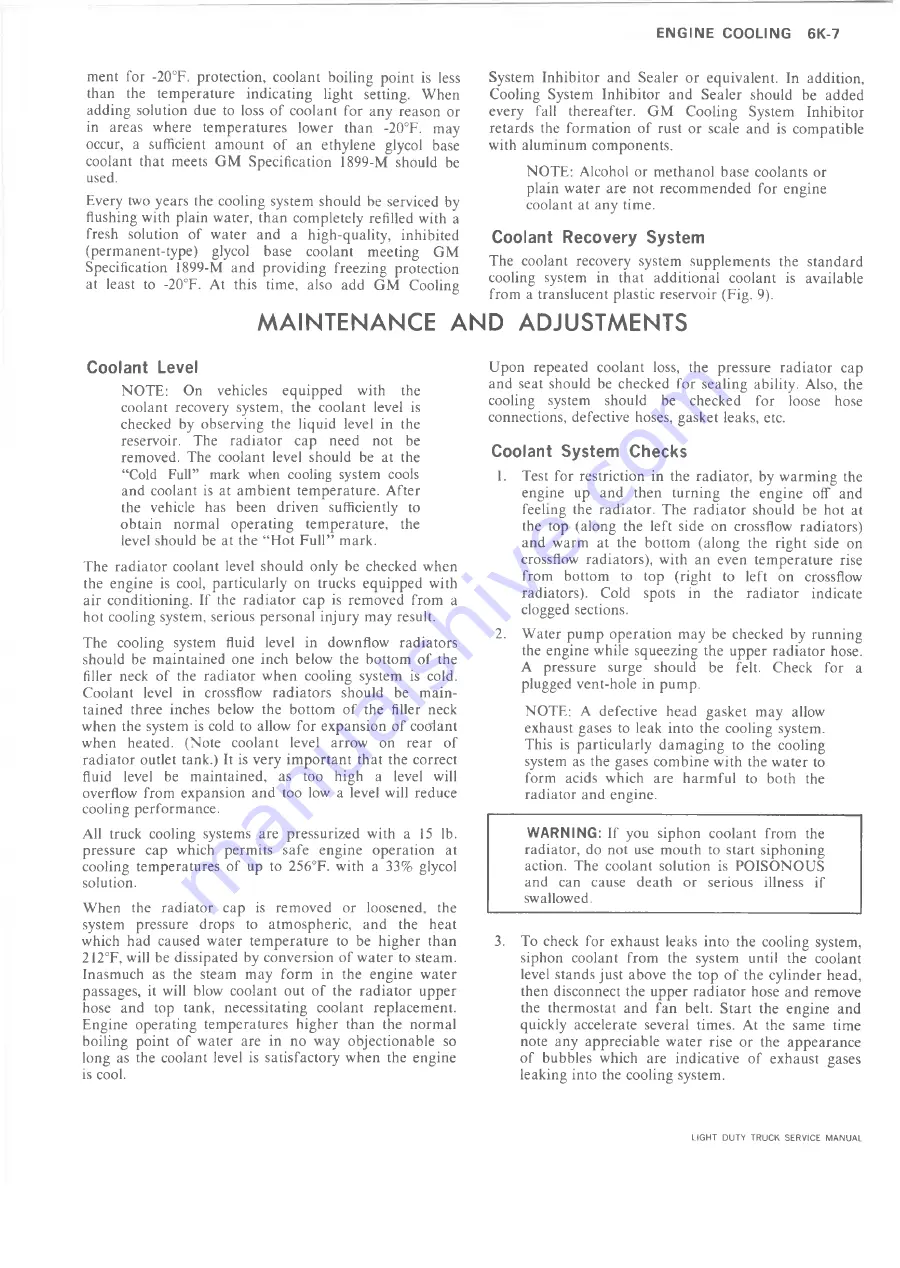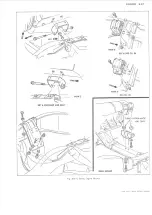
E N G I N E C O O L I N G
6 K -7
ment for -20°F. protection, coolant boiling point is less
than the temperature indicating light setting. When
adding solution due to loss of coolant for any reason or
in areas where temperatures lower than -20°F. may
occur, a sufficient amount of an ethylene glycol base
coolant that meets GM Specification 1899-M should be
used.
Every two years the cooling system should be serviced by
flushing with plain water, than completely refilled with a
fresh solution of water and a high-quality, inhibited
(permanent-type) glycol base coolant meeting GM
Specification 1899-M and providing freezing protection
at least to -20°F. At this time, also add GM Cooling
System Inhibitor and Sealer or equivalent. In addition,
Cooling System Inhibitor and Sealer should be added
every fall thereafter. GM Cooling System Inhibitor
retards the formation of rust or scale and is compatible
with aluminum components.
NOTE: Alcohol or methanol base coolants or
plain water are not recommended for engine
coolant at any time.
Coolant Recovery System
The coolant recovery system supplements the standard
cooling system in that additional coolant is available
from a translucent plastic reservoir (Fig. 9).
M A IN TE N A N C E A N D ADJUSTMENTS
Coolant Level
NOTE: On vehicles equipped with the
coolant recovery system, the coolant level is
checked by observing the liquid level in the
reservoir. The radiator cap need not be
removed. The coolant level should be at the
“Cold Full” mark when cooling system cools
and coolant is at ambient temperature. After
the vehicle has been driven sufficiently to
obtain normal operating temperature, the
level should be at the “Hot Full” mark.
The radiator coolant level should only be checked when
the engine is cool, particularly on trucks equipped with
air conditioning. If the radiator cap is removed from a
hot cooling system, serious personal injury may result.
The cooling system fluid level in downflow radiators
should be maintained one inch below the bottom of the
filler neck of the radiator when cooling system is cold.
Coolant level in crossflow radiators should be main
tained three inches below the bottom of the filler neck
when the system is cold to allow for expansion of coolant
when heated. (Note coolant level arrow on rear of
radiator outlet tank.) It is very important that the correct
fluid level be maintained, as too high a level will
overflow from expansion and too low a level will reduce
cooling performance.
All truck cooling systems are pressurized with a 15 lb.
pressure cap which permits safe engine operation at
cooling temperatures of up to 256°F. with a 33% glycol
solution.
When the radiator cap is removed or loosened, the
system pressure drops to atmospheric, and the heat
which had caused water temperature to be higher than
212°F, will be dissipated by conversion of water to steam.
Inasmuch as the steam may form in the engine water
passages, it will blow coolant out of the radiator upper
hose and top tank, necessitating coolant replacement.
Engine operating temperatures higher than the normal
boiling point of water are in no way objectionable so
long as the coolant level is satisfactory when the engine
is cool.
Upon repeated coolant loss, the pressure radiator cap
and seat should be checked for sealing ability. Also, the
cooling system should be checked for loose hose
connections, defective hoses, gasket leaks, etc.
Coolant System Checks
1. Test for restriction in the radiator, by warming the
engine up and then turning the engine off and
feeling the radiator. The radiator should be hot at
the top (along the left side on crossflow radiators)
and warm at the bottom (along the right side on
crossflow radiators), with an even temperature rise
from bottom to top (right to left on crossflow
radiators). Cold spots in the radiator indicate
clogged sections.
2. Water pump operation may be checked by running
the engine while squeezing the upper radiator hose.
A pressure surge should be felt. Check for a
plugged vent-hole in pump.
NOTE: A defective head gasket may allow
exhaust gases to leak into the cooling system.
This is particularly damaging to the cooling
system as the gases combine with the water to
form acids which are harmful to both the
radiator and engine.
W ARNING:
If you siphon coolant from the
radiator, do not use mouth to start siphoning
action. The coolant solution is POISONOUS
and can cause death or serious illness if
swallowed.
3. To check for exhaust leaks into the cooling system,
siphon coolant from the system until the coolant
level stands just above the top of the cylinder head,
then disconnect the upper radiator hose and remove
the thermostat and fan belt. Start the engine and
quickly accelerate several times. At the same time
note any appreciable water rise or the appearance
of bubbles which are indicative of exhaust gases
leaking into the cooling system.
LIGHT DUTY TRUCK SERVICE MANUAL
Summary of Contents for Light Duty Truck 1973
Page 1: ......
Page 4: ......
Page 6: ......
Page 53: ...HEATER AND AIR CONDITIONING 1A 27 LIGHT DUTY TRUCK SERVICE MANUAL...
Page 115: ...LIGHT DUTY TRUCK SERVICE M A N U A L HEATER AND AIR CONDITIONING 1A 89...
Page 123: ...BODY 1B 3 Fig 6 Typical 06 Van LIGHT DUTY TRUCK SERVICE MANUAL...
Page 149: ...BODY 1B 29 Fig 84 Body Mounting 06 Fig 85 Body Mounting 14 LIGHT DUTY TRUCK SERVICE MANUAL...
Page 171: ...LIGHT DUTY TRUCK SERVICE M A N U A L Fig 2 Frame Horizontal Checking Typical FRAME 2 3...
Page 173: ...LIGHT DUTY TRUCK SERVICE M A N U A L Fig 4 10 30 Series Truck Frame FRAME 2 5...
Page 174: ...2 6 FRAME LIGHT DUTY TRUCK SERVICE MANUAL Fig 5 Underbody Reference Points G Van...
Page 185: ...FRONT SUSPENSION 3 11 Fig 16 Toe out on Turns LIGHT DUTY TRUCK SERVICE MANUAL...
Page 224: ......
Page 266: ......
Page 351: ...ENGINE 6 15 Fig ID Sectional View of Eight Cylinder Engine LIGHT DUTY TRUCK SERVICE MANUAL...
Page 375: ...EN G IN E 6 39 LIGHT DUTY TRUCK SERVICE MANUAL...
Page 376: ...6 4 0 ENGINE LIGHT DUTY TRUCK SERVICE MANUAL...
Page 377: ...ENG IN E 6 41 LIGHT DUTY TRUCK SERVICE MANUAL...
Page 378: ...LIGHT DUTY TRUCK SERVICE MANUAL Fig 37L K Series Engine Front Mount 6 42 ENG INE...
Page 400: ...6 6 4 ENG INE LIGHT DUTY TRUCK SERVICE MANUAL...
Page 401: ...ENG IN E 6 65 LIGHT DUTY TRUCK SERVICE MANUAL...
Page 402: ...6 6 6 ENGINE LIGHT DUTY TRUCK SERVICE MANUAL...
Page 403: ...E NG IN E 6 67 Fig 36V C Series Engine Mounts LIGHT DUTY TRUCK SERVICE MANUAL...
Page 410: ......
Page 423: ...EN G IN E C OOLING 6K 13 Fig 16 Overheating Chart LIGHT DUTY TRUCK SERVICE MANUAL...
Page 424: ...6 K 1 4 ENG INE COOLING Fig 17 Coolant Loss Chart LIGHT DUTY TRUCK SERVICE MANUAL...
Page 456: ...6M 32 ENGINE FUEL Fig K15 Accelerator Controls G Van L 6 LIGHT DUTY TRUCK SERVICE MANUAL...
Page 492: ......
Page 512: ...Fig 18e Vacuum Advance Diagram V8 Engine...
Page 516: ...6 T 2 4 E M IS S IO N CONTROL SYSTEMS LIGHT DUTY TRUCK SERVICE MANUAL...
Page 528: ......
Page 590: ......
Page 593: ...CLUTCHES MANUAL TRANSMISSIONS 7M 3 LIGHT DUTY TRUCK SERVICE MANUAL...
Page 598: ...7M 8 CLUTCHES MANUAL TRANSMISSIONS LIGHT DUTY TRUCK SERVICE MANUAL...
Page 642: ......
Page 654: ......
Page 743: ...FUEL TANKS AND EXHAUST 8 13 LIGHT DUTY TRUCK SERVICE MANUAL...
Page 744: ...8 14 FUEL TANKS AND EXHAUST LIGHT DUTY TRUCK SERVICE MANUAL...
Page 760: ...8 30 FUEL TANKS AND EXHAUST Fig 40 Exhaust Pipe P Models LIGHT DUTY TRUCK SERVICE MANUAL...
Page 761: ...FUEL TANKS AND EXHAUST 8 31 LIGHT DUTY TRUCK SERVICE MANUAL...
Page 763: ...FUEL TANKS AND EXHAUST 8 33 LIGHT DUTY TRUCK SERVICE MANUAL...
Page 766: ......
Page 832: ...LIGHT DUTY TRUCK SERVICE MANUAL Fig 106 Power Steering Pump Mounting Typical 9 66 STEERING...
Page 833: ...PUMP ASSEMBLY STEERING GEAR TYPICAL SMALL V8 TYPICAL LARGE V8 STEERING 9 67...
Page 861: ...STEERING 9 95 Fig 134 Power Steering Pump Leakage LIGHT DUTY TRUCK SERVICE MANUAL...
Page 864: ......
Page 876: ......
Page 886: ...11 10 CHASSIS SHEET METAL LIGHT DUTY TRUCK SERVICE MANUAL...
Page 891: ...ELECTRICAL BODY AND CHASSIS 12 5 LIGHT DUTY TRUCK SERVICE MANUAL...
Page 934: ......
Page 942: ......
Page 970: ......
Page 972: ......
Page 974: ......
Page 976: ...V...
Page 978: ......
Page 979: ......







































